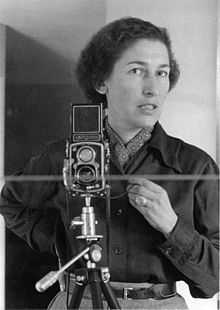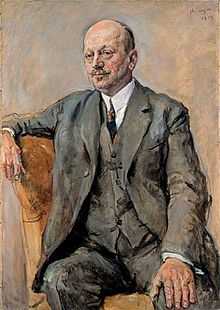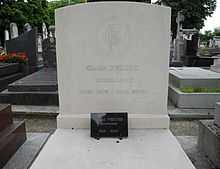Gisèle Freund

Gisèle Freund (born Gisela Freund; November 19, 1908 Schöneberg District, Berlin – March 31, 2000, Paris) was a German-born French photographer and photojournalist, famous for her documentary photography and portraits of writers and artists. Her best-known book is Photographie et société (1974) about the uses and abuses of the photographic medium in the age of technological reproduction. In 1977, she became President of the French Association of Photographers, and in 1981, she took the official portrait of French President François Mitterrand.
She was made Officier des Arts et Lettres in 1982 and Chevalier de la Légion d'honneur, the highest decoration in France, in 1983. In 1991, she became the first photographer to be honored with a retrospective at the Musée National d’art Moderne in Paris (Centre Georges Pompidou).[1]
Freund's major contributions to photography include using the Leica (with its 36 frames) for documentary reportage and her early experimentation with Kodachrome and 35 mm Agfacolor, which allowed her to develop a "uniquely candid portraiture style" that distinguishes her in 20th century photography.[2]
She is buried at the Montparnasse Cemetery in Paris, France near her home and studio at 12 rue Lalande.
Biography

Freund was born into a textile merchant family on 19 December 1908 to Julius and Clara (nee Dressel) Freund, a wealthy Jewish couple in the Schoneberg district of Berlin.
Her father, Julius Freund, was a keen art collector with an interest in the work of photographer Karl Blossfeldt, whose close-up studies explored the forms of natural objects. Freund's father bought Gisèle her first camera, a Voigtlander 6x9 in 1925 and a Leica camera as a present for her graduation in 1929.[3]
In 1931, Freund studied sociology and art history at Albert-Ludwigs-Universität Freiburg, Breisgau, Germany; and from 1932-33 she studied at the Institute for Social, Sciences, University of Frankfurt under Theodor W. Adorno, Karl Mannheim and Norbert Elias (also known as the Frankfurt School).[4] At university she became an active member of a student socialist group and was determined to use photography as an integral part of her socialist practice. One of her first first stories, shot on May 1, 1932, "shows a recent march of anti-fascist students" who had been "regularly attacked by Nazi groups." [5] The photos show Walter Benjamin, a good friend of Freund, and Bertolt Brecht.
In March 1933, a month after Adolf Hitler rose to power in Germany, Walter Benjamin fled to Paris on May 30, Gisèle followed him since she was both a socialist activist and a Jew. She escaped to Paris with her negatives strapped around her body to get them past the border guards. Gisèle and Walter Benjamin would continue their friendship in Paris, where Freund would famously photograph him reading at the National Library. They both studied and wrote about art in the 19th and 20th centuries as Freund continued her studies at the Sorbonne.[6]
In 1935, Andre Malraux invited Freund to document First International Congress in Defence of Culture in Paris, where she was introduced to and subsequently photographed many of the notable French artists of her day.[7] Freund befriended the famed literary partners, Sylvia Beach of Shakespeare and Company, and Adrienne Monnier of Maison des Amis des Livres. In 1935, Monnier arranged a marriage of convenience for Freund with Pierre Blum so that Freund could obtain a visa to remain in France legally.
In 1936, while Sylvia Beach was visiting the United States, Freund moved into Monnier and Beach's shared apartment and they became intimates. When Beach returned, she ended her intimate relationship with Monnier yet maintained a strong friendship with both Monnier and Freund.[8] Freund finished her Ph.D. in Sociology and Art at the Sorbonne in 1936,[9] and Monnier published the doctoral dissertation as "La photographie en France au dix-neuvieme siècle," under the La Maison des Amis des Livres imprint.
Monnier "introduced [Freund] to the artists and writers who would prove her most captivating subjects."[10] Later that year, Freund became internationally famous with her photojournalistic piece, "Northern England," which was published in Life Magazine on December 14, 1936 and showed the effects of the depression in England. No magazine in France could publish color photographs at that time, so Freund's work with Life—one of the first color mass magazines—would start a lifelong relationship between the photographer and magazine.[11]
In 1938, Monnier suggested that Freund photograph James Joyce for his upcoming book, Finnegans Wake. Joyce, who disliked being photographed, invited Freund to his Paris flat for a private screening of her previous work. He was impressed enough by Freund's work to allow her to photograph him, and over a period of three days, she captured the most intimate portraits of Joyce during his time in Paris.[12]

On June 10, 1940,[13] with the Nazi invasion of Paris looming, Freund escaped Paris to Free France in the Dordogne. Her husband by convenience, Pierre, had been captured by the Nazis and sent to a prison camp. He was able to escape and met with Freund before going back to Paris to fight in the Resistance. As the wife of an escaped prisoner, a Jew, and a Socialist, Freund "feared for her life."[14]
In 1942, with the help of André Malraux, who told his friends, "we must save Gisele!,"[15] Freund fled to Buenos Aires, Argentina "at the invitation of Victoria Ocampo, director of the periodical Sur. Ocampo was at the center of the Argentinean intellectual elite, and through her Freund met and photographed many great writers and artists, such as Jorge Luis Borges and Pablo Neruda."[16]
While living in Argentina, Freund started a publishing venture called Ediciones Victoria. She writes, "In reality, I started this for the De Gaulle government in exile where I was working in the Information ministry, volontairement without payment."[17] She also founds a relief action committee for French artists and becomes a spokesperson for Free France.
In 1947, Freund signed a contract with Magnum Photos as a Latin America contributor, but by 1954, she was declared persona non grata by the U.S. Government at the height of the Red Scare for her socialist views, and Robert Capa forced her to break ties with Magnum. In 1950, her photocoverage of an bejewelled Eva Peron for Life Magazine caused a diplomatic stir between the United States and Argentina and upset many of Peron's supporters—the ostentatious photographs went against the official party line of austerity; Life Magazine was blacklisted in Argentina, and once again, Freund had to escape a country with her negatives. She moved to Mexico and became friends with Diego Rivera, Frida Kahlo, Alfaro Siqueiros, and Jose Luis Orozco.[18] In 1953, she moved back to Paris permanently. Over the life of her career, she went on over 80 photojournalism assignments, primarily for Life Magazine and "Time Magazine",[19] but also Du, The Sunday Times (London), Vu, Picture Post, Weekly Illustrated, and Paris-Match, among others. From the 1960s onward, Freund continued to write, and her reputation as an important portrait photographer grew with each successive exhibition. She is now celebrated as one of the best portrait photographers of the twentieth century: Upon her death, "President Jacques Chirac praised her as 'one of the world's greatest photographers..[20]
Notable work
In 1936 Freund photographed the effects of the Depression in England for Life Magazine. Freund's dissertation was published in book form by Adrienne Monnier (1892–1955). One of her best-known early works shows her friends Walter Benjamin and Bertolt Brecht participating in one of the last political street demonstrations in Germany before Hitler took power.
In 1938, Freund had the opportunity to photograph James Joyce in Paris through her connections with Adrienne Monnier and Sylvia Beach. In her notebooks, she describes a taxi crash after one such photo-session which caused her cameras to crash to the ground. She called Joyce and said, "Mr. Joyce, you damned my photos — you put some kind of a bad Irish spell on them and my taxi crashed. I was almost killed and your photos are ruined”.[21] Time Magazine used one of these photos for its cover on May 8, 1939. The series of photographs would eventually be published in 1965 in James Joyce in Paris: His Final Years by Freund and V. B. Carleton and a Preface by Simone de Beauvoir.[22] Freund became famous for her portraits of literary geniuses, including Samuel Beckett, Virginia Woolf, George Bernard Shaw and many others.
In Freund's obituary for The New York Times, Suzanne Daley writes, "[Freund] specialized in conveying the attitude of her subjects. She focused on hands, body posture and clothing. Reviewing an exhibition of her life's work in 1979, Hilton Kramer wrote in The New York Times that she excelled in 'brilliant documentation rather than originality.' In a 1996 interview, Ms. Freund said she read her subjects' work and often spent hours discussing their books with them before taking a portrait." Indeed, it was Freund's ability to connect with writers and artists—especially the famously difficult James Joyce—that gave her the ability to photograph them with their guards down.[23]
Quotations
From "Photographer" (1985)
- "For a writer, his portrait is the only link he can establish with his readers. When we read a book whose content moves us, we are interested to look at the author's face, which is generally printed on the jacket since the publisher is aware of our wish to see if these features correspond to the idea we have formed of the author. This image is thus very important to the man of letters. He prefers a photographer in whom he can have confidence."
From Photography & Society
- "The lens, the so-called impartial eye, actually permits every possible distortion of reality: the character of the image is determined by the photographer's point of view and the demands of his patrons. The importance of photography does not rest primarily in its potential as an art form, but rater in its ability to shape our ideas, to influence our behaviour, and to define our society" (4).
- "In our technological age, when industry is always trying to create new needs, the photographic industry has expanded enormously because the photograph meets modem man's pressing need to express his own individuality" (5).
- Although the first inventor of photography, Nicéphore Niépce, tried desperately to have his invention recognized, his efforts were in vain and he died in misery. Few people know his name today. But photography, which he discovered, has be come the most common language of our civilization" (218).
- "When you do not like human beings, you cannot make good portraits."
Exhibitions
- 2014 "Gisèle Freund: Photographic scenes and portraits" (Berlin, Academy of Arts)
- 2014 "From Paris to Victoria: Gisèle Freund's James Joyce Photographs." University of Victoria, Canada
- 2011-2012 "Gisèle Freund: L'Œil frontière, Paris 1933-1940", (Fondation Pierre Bergé - Yves Saint Laurent)
- 2008 "Gisèle Freund, ritratti d'autore" Galleria Carla Sozzani, Milan, Italy;[24] "Gisèle Freund reframes Berlin, 1957-1962," Ephraim-Palais, Berlin.[25]
- 2006 "Susana Soca and her circles seen by Gisèle Freund," Maison de l'Amerique latine, Paris, France; Montevideo, Uruguay; Soca, Uruguay[26]
- 2002 "El mon i la meva camera-Gisèle Freund," Centre de Cultura Contemporanea, Barcelona; Fundacio Sa Nostra, Palma de Majorque, Spain
- 1999 "Adrienne Monnier, Saint John Perse et les amis des livres," Musee Municipal Saint John Perse; Point-a-Pitre, and the Fondation Saint John Perse, Aix-en-Provence, France
- 1996 "Gisèle Freund, 1st International Congress of Writers for the Defence of Culture, Paris 1935," Goethe Institute, Paris, France; Sprengel Museum, Hanover, Germany; "Malraux sous le regard de Gisele Freund, Galerie du Jeu de Paume, Paris, France; Verso Gallery, Tokyo, Japan; Galerie Michiko Matsumoto, Tokyo, Japan; "Gisele Freund: Berlin, Frankfurt, Paris: Fotographien 1929-1962, Berliner Festspeil, Berlin, Germay
- 1995 Museum of Modern Art, Frankfurt, Germany
- 1994 Galerie Clairefontaine, Luxembourg
- 1993 "Gisèle Freund," Seoul Museum, South Korea
- 1992 Center for Contemporary Art, Mexico
- 1991 "Gisèle Freund, Itinéraires," Musée National d'Art Moderne, Centre Georges-Pompidou, Paris, France;[27] "Frida Kahlo et ses amis," Galerie de France, Paris.
- 1991 Photo Art Gallery, Bale, France
- 1989 "Gisèle Freund: James Joyce, 1939," Galerie de France, Paris, France; "Gisèle Freund, James Joyce in Paris," Galerie Anita Neugebauer, Photo Art Basel, Switzerland & Bale, France
- 1988 "Gisèle Freund," Werkbund-Archiv, Museum der Alltagskultur des 20." Berlin, Germany
- 1987 Galerie zur Stockeregg, Zurich, Switzerland; "Photographs of James Joyce and Friends" Gotham Book Mart & Gallery, New York, USA
- 1986 "Itinéraires," Galerie de France, Paris
- 1984 Fotoforum, Frankfurt, Germany
- 1983 Boston National Library, USA; Center for Creative Art, New Orleans, USA; Stanford University Museum
- 1982 Koplin Gallery, Los Angeles, USA; The Photographers Gallery, London
- 1981 Galerie municipale du Chateau d'Eau, Toulouse, France; Center for Creative Photography, Tucson, Arizona, USA; Axiom Gallery, Sidney, Australia.
- 1980 Galerie Agathe Gaillard, Paris, France; Photo Art Basel, Switzerland
- 1979 Sidney Janis Gallery, New York, USA
- 1978 Watari Museum of Contemporary Art, Tokyo, Japan; Shadai Gallery, Tokyo, Japan; Marcus Krakow Gallery, Boston, USA
- 1977 "A Retrospective," Rheinisches Landesmuseum, Bonn, Germany [Gisèle Freund: Fotographien 1932-1977]; Musée Réattu, Arles; Fotoforum, Frankfurt; Documenta 6, Kassel, Germany; David Mirvich Gallery, Toronto, Canada.
- 1976 Focus Gallery, San Francisco, California, USA
- 1975 "Giselle Freund [sic]," Robert Schoelkopf Gallery, New York, USA
- 1973 Musee Descartes, Amsterdam, Netherlands
- 1968 "Au pays des visages, 1938-1968: trente ans d'art et de litterature a travers la camera de Gisèle Freund [In the realm of faces: thirty years of art and literature through the lens of Gisèle Freund]." Musee Art moderne de la ville de Paris & Fondation Rayaumont, Asnieres-sur-Oise
- 1966 American Centre, Paris, France
- 1965 Princeton Art Museum, USA
- 1963 "Le portrait francias au xxe siecle [French portraiture in the 20th Century]," Bibliothèque nationale de France, Cabinet des estampes, Paris, France & Berlin and Dusseldorf, Germany
- 1962 Musee des Beaux-Arts de la Ville a Paris—Petit Palais, France
- 1946 Maison de l'Amerique latine, Paris, France
- 1945 Palacio de Bellas Artes, Valparaiso Galeria de Arte, Buenos Aries, Argentina
- 1942 Galerie Amigos del Arte, Buenos Aires, Argentina
- 1939 La Maison des Amis des Livres, Paris, France
- 1938 Private viewing for James Joyce in his Paris apartment (on his request to see if he liked her work)
Books published by Gisèle Freund
- "La photographie en France au dix-neuvieme siècle" [French Photography in the 19th Century], Paris, La Maison des Amis des Livres, (1936)
- "France" (1945)
- "Mexique precolombien" [Pre-Columbian Mexico] (1954)
- "James Joyce in Paris. His final years" (1965)
- "Le monde et ma camera" [The World and My Camera] (1970)
- "Photographie et societe" [Photography and Society] (1974)
- "Memoires de l’Oeil" [My Eye's Memories] (1977)
- "Portfolio: Au pays des visages" [Portfolio: the Landscape of faces] (1978)
- "Trois Jours avec Joyce" [Three Days with Joyce] (1982)
- "Itineraires" [Itinerary] (1985)
- "Gisèle Freund, Portraits d'ecrivains et d'artistes [Gisèle Freund's Portraits of writers and Artists] (1989)
- "Gisèle Freund, portrait. Entretiens avec Rauda Jamis [Portrait: Interviews with Rauda Jamis] (1991)
- "The Poetry of the Portrait: Photographs of Writers and Artists" (1998)
- "La Photgraphie en France au dix-neuvieme siecle" [Revised and expanded edition with Andre Gunthert] (2011)
Awards
- 1989 Doctor honoris causa, National Museum of Photography at Bradford University[28]
- 1983 Chevalier de la Légion d'Honneur (France)
- 1982 Officier des Arts et Lettres (France)
- 1980 Grand prix national des Arts pour la Photographie (France)
- 1978 German Society's cultural photography prize (Germany)[29]
- 1977 Elected President, French Federation of Creative Photographers (France)[30]
Books about Gisèle Freund
- 2011 Catalogue de l'exposition Gisèle Freund L'Oeil Frontière Paris 1933-1940[31]
- 1998 Gisèle Freund[32]
- 1994 You have seen their faces : Gisèle Freund, Walter Benjamin and Margaret Bourke-White as headhunters of the thirties
[[<ref>http://www.worldcat.org/title/you-have-seen-their-faces-gisele-freund-walter-benjamin-and-margaret-bourke-white-as-headhunters-of-the-thirties/oclc/32087994&referer=brief_results</ref>]]
- 1991 Catalogue de l'œuvre photographique Gisèle Freund
- 1985 Gisèle Freund, photographer
Newspaper Articles about Gisèle Freund
2009 The New York Times A Berliner’s Portraits of People and Her Familiar, and Foreign, Home
Film and television
1996 The documentary Paris Was a Woman features interviews with Dr. Gisèle Freund as she recollects her experiences in Paris during the 1930s.
1979 Zeugen des Jahrhunderts [Witnesses of the Century].
Rights and permissions
Freund's estate is managed through l’Institut Mémoires de l’édition contemporaine (IMEC), Paris, France
External links
- Robert Mapplethrope's photograph of Gisèle Freund
- The Fondation Pierre Bergé – Yves Saint Laurent Includes video and press kit
- Jewish Women's Archive written by Carlene Meeker
- Gisele Freund fonds at University of Victoria, Special Collections
- Gisèle Freund Photographs of James Joyce in Paris at University of Victoria, Special Collections
- GLBTQ: An Encyclopedia of Gay, Lesbian, Bisexual, Transgender, and Queer Culture
- Peggy Guggenheim Museum
- About women's history
- A biography
References
- ↑ Meeker, Carlene. Jewish Women's Archive
- ↑ Zox-Weaver, Annalisa. "Gisele Freund." Encyclopedia of Twentieth-Century Photography. Ed. Lynne Warren. (564-566).
- ↑ Stiftung Stadtmuseum Catalogue for "Gisèle Freund: A Revisit to Berlin, 1957-1962"
- ↑ Zox-Weaver, Annalisa. "Gisele Freund." Encyclopedia of Twentieth-Century Photography. Ed. Lynne Warren. (564-566).
- ↑ http://blogs.rue89.nouvelobs.com/oelpv/2011/11/29/gisele-freund-et-walter-benjamin-les-amis-retrouves-225828
- ↑ http://blogs.rue89.nouvelobs.com/oelpv/2011/11/29/gisele-freund-et-walter-benjamin-les-amis-retrouves-225828
- ↑ http://www.fondation-pb-ysl.net/medias/fichiers/DP_Gisele_Freund_2011_UK_WEB.pdf
- ↑ The Very Rich Hours of Adrienne Monnier. viii
- ↑ Zox-Weaver, Annalisa
- ↑ Zox-Weaver
- ↑ Zox-Weaver
- ↑ Freund, Gisele. James Joyce in Paris: His Final Years
- ↑ Freund, Gisele. The World in My Camera
- ↑ The World in My Camera
- ↑ Daley, Suzanne, "Gisele Freund Is Dead at 91; Photographed Paris Writers." New York Times, April 1, 2000
- ↑ Meeker, Carlene. "Gisele Freund." http://jwa.org/encyclopedia/article/freund-gisele
- ↑ Letter to Verna B. Carleton, January 7, 1965
- ↑ Stiftung Stadtmuseum Catalogue for "Gisele Freund: A Revisit to Berlin, 1957-1962"
- ↑ http://www.gisele-freund.com/biography/
- ↑ http://www.nytimes.com/2000/04/01/arts/gisele-freund-is-dead-at-91-photographed-paris-writers.html
- ↑ http://www.nytimes.com/2011/10/20/arts/the-elegance-of-gisele-freund.html?pagewanted=all&_r=0
- ↑ http://www.worldcat.org/title/james-joyce-in-paris-his-final-years/oclc/295884&referer=brief_results
- ↑ http://www.nytimes.com/2000/04/01/arts/gisele-freund-is-dead-at-91-photographed-paris-writers.html
- ↑ http://www.worldcat.org/title/gisele-freund-ritratti-dautore-1908-2008-cento-anni-dalla-nascita/oclc/190838214
- ↑ http://www.nytimes.com/slideshow/2009/01/08/arts/design/20090108_ABROAD_index.html?_r=0
- ↑ Encyclopedia of Twentieth-Century Photography, Volume 1
- ↑ http://www.nytimes.com/2011/10/20/arts/the-elegance-of-gisele-freund.html?pagewanted=all
- ↑ http://www.theguardian.com/news/2000/apr/01/guardianobituaries1
- ↑ http://www.theguardian.com/news/2000/apr/01/guardianobituaries1
- ↑ http://www.theguardian.com/news/2000/apr/01/guardianobituaries1
- ↑ http://www.worldcat.org/title/gisele-freund-loeil-frontiere-paris-1933-1940/oclc/770222870&referer=brief_results
- ↑ http://www.worldcat.org/title/gisele-freund/oclc/21045272&referer=brief_results
|
Template:France-photographer